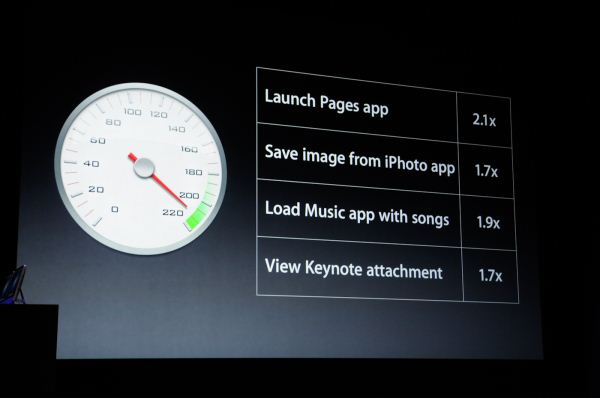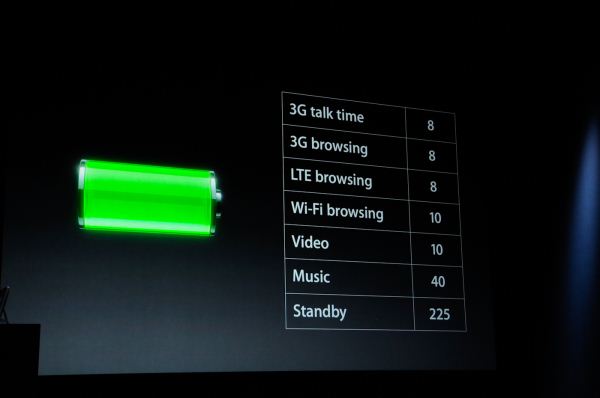The iPhone 5's A6 SoC: Not A15 or A9, a Custom Apple Core Instead
by Anand Lal Shimpi on September 15, 2012 2:15 PM EST- Posted in
- Smartphones
- Apple
- Mobile
- SoCs
- iPhone 5
When Apple announced the iPhone 5, Phil Schiller officially announced what had leaked several days earlier: the phone is powered by Apple's new A6 SoC.
As always, Apple didn't announce clock speeds, CPU microarchitecture, memory bandwidth or GPU details. It did however give us an indication of expected CPU performance:
Prior to the announcement we speculated the iPhone 5's SoC would simply be a higher clocked version of the 32nm A5r2 used in the iPad 2,4. After all, Apple seems to like saving major architecture shifts for the iPad.
However, just prior to the announcement I received some information pointing to a move away from the ARM Cortex A9 used in the A5. Given Apple's reliance on fully licensed ARM cores in the past, the expected performance gains and unpublishable information that started all of this I concluded Apple's A6 SoC likely featured two ARM Cortex A15 cores.
It turns out I was wrong. But pleasantly surprised.
The A6 is the first Apple SoC to use its own ARMv7 based processor design. The CPU core(s) aren't based on a vanilla A9 or A15 design from ARM IP, but instead are something of Apple's own creation.
Hints in Xcode 4.5
The iPhone 5 will ship with and only run iOS 6.0. To coincide with the launch of iOS 6.0, Apple has seeded developers with a newer version of its development tools. Xcode 4.5 makes two major changes: it drops support for the ARMv6 ISA (used by the ARM11 core in the iPhone 2G and iPhone 3G), keeps support for ARMv7 (used by modern ARM cores) and it adds support for a new architecture target designed to support the new A6 SoC: armv7s.
What's the main difference between the armv7 and armv7s architecture targets for the LLVM C compiler? The presence of VFPv4 support. The armv7s target supports it, the v7 target doesn't. Why does this matter?
Only the Cortex A5, A7 and A15 support the VFPv4 extensions to the ARMv7-A ISA. The Cortex A8 and A9 top out at VFPv3. If you want to get really specific, the Cortex A5 and A7 implement a 16 register VFPv4 FPU, while the A15 features a 32 register implementation. The point is, if your architecture supports VFPv4 then it isn't a Cortex A8 or A9.
It's pretty easy to dismiss the A5 and A7 as neither of those architectures is significantly faster than the Cortex A9 used in Apple's A5. The obvious conclusion then is Apple implemented a pair of A15s in its A6 SoC.
For unpublishable reasons, I knew the A6 SoC wasn't based on ARM's Cortex A9, but I immediately assumed that the only other option was the Cortex A15. I foolishly cast aside the other major possibility: an Apple developed ARMv7 processor core.
Balancing Battery Life and Performance
There are two types of ARM licensees: those who license a specific processor core (e.g. Cortex A8, A9, A15), and those who license an ARM instruction set architecture for custom implementation (e.g. ARMv7 ISA). For a long time it's been known that Apple has both types of licenses. Qualcomm is in a similar situation; it licenses individual ARM cores for use in some SoCs (e.g. the MSM8x25/Snapdragon S4 Play uses ARM Cortex A5s) as well as licenses the ARM instruction set for use by its own processors (e.g. Scorpion/Krait implement in the ARMv7 ISA).
For a while now I'd heard that Apple was working on its own ARM based CPU core, but last I heard Apple was having issues making it work. I assumed that it was too early for Apple's own design to be ready. It turns out that it's not. Based on a lot of digging over the past couple of days, and conversations with the right people, I've confirmed that Apple's A6 SoC is based on Apple's own ARM based CPU core and not the Cortex A15.
Implementing VFPv4 tells us that this isn't simply another Cortex A9 design targeted at higher clocks. If I had to guess, I would assume Apple did something similar to Qualcomm this generation: go wider without going substantially deeper. Remember Qualcomm moved from a dual-issue mostly in-order architecture to a three-wide out-of-order machine with Krait. ARM went from two-wide OoO to three-wide OoO but in the process also heavily pursued clock speed by dramatically increasing the depth of the machine.
The deeper machine plus much wider front end and execution engines drives both power and performance up. Rumor has it that the original design goal for ARM's Cortex A15 was servers, and it's only through big.LITTLE (or other clever techniques) that the A15 would be suitable for smartphones. Given Apple's intense focus on power consumption, skipping the A15 would make sense but performance still had to improve.
Why not just run the Cortex A9 cores from Apple's A5 at higher frequencies? It's tempting, after all that's what many others have done in the space, but sub-optimal from a design perspective. As we learned during the Pentium 4 days, simply relying on frequency scaling to deliver generational performance improvements results in reduced power efficiency over the long run.
To push frequency you have to push voltage, which has an exponential impact on power consumption. Running your cores as close as possible to their minimum voltage is ideal for battery life. The right approach to scaling CPU performance is a combination of increasing architectural efficiency (instructions executed per clock goes up), multithreading and conservative frequency scaling. Remember that in 2005 Intel hit 3.73GHz with the Pentium Extreme Edition. Seven years later Intel's fastest client CPU only runs at 3.5GHz (3.9GHz with turbo) but has four times the cores and up to 3x the single threaded performance. Architecture, not just frequency, must improve over time.
At its keynote, Apple promised longer battery life and 2x better CPU performance. It's clear that the A6 moved to 32nm but it's impossible to extract 2x better performance from the same CPU architecture while improving battery life over only a single process node shrink.
Despite all of this, had it not been for some external confirmation, I would've probably settled on a pair of higher clocked A9s as the likely option for the A6. In fact, higher clocked A9s was what we originally claimed would be in the iPhone 5 in our NFC post.
I should probably give Apple's CPU team more credit in the future.
The bad news is I have no details on the design of Apple's custom core. Despite Apple's willingness to spend on die area, I believe an A15/Krait class CPU core is a likely target. Slightly wider front end, more execution resources, more flexible OoO execution engine, deeper buffers, bigger windows, etc... Support for VFPv4 guarantees a bigger core size than the Cortex A9, it only makes sense that Apple would push the envelope everywhere else as well. I'm particularly interested in frequency targets and whether there's any clever dynamic clock work happening. Someone needs to run Geekbench on an iPhone 5 pronto.
I also have no indication how many cores there are. I am assuming two but Apple was careful not to report core count (as it has in the past). We'll get more details as we get our hands on devices in a week. I'm really interested to see what happens once Chipworks and UBM go to town on the A6.













163 Comments
View All Comments
techconc - Monday, September 17, 2012 - link
@tobi1449:Certainly, you've never actually used an iPhone 4 otherwise you'd know that your claims are patently false. My wife has an iPhone 4, you can't just make the signal completely drop by bridging the antenna gap. This "issue" didn't result in any more actual lost calls than other phones. The "issue" was corrected in software as to how the signal strength was being reported. Yes, multi-antenna designs are more consistent with regard to reception but even at it's worst, the iPhone 4 design is nowhere near what you describe. Further, this discussion is a bit off topic.
rarson - Tuesday, September 18, 2012 - link
Yeah, and that class action lawsuit for Mag"Safe" adapters catching fire didn't happen either.Apple products suck. They really do.
moogleii - Tuesday, September 18, 2012 - link
Your response to his antenna argument is a giant red herring? I guess all car manufacturers suck because at some point in time, one of their products had an issue. Or any manufacturer really.http://www.arcfn.com/2012/05/apple-iphone-charger-...
Looks like quality engineering there to me. But hey, let's all resort to knee-jerk fanboy-ism.
Your argument sucks. It really does. Honestly, I shouldn't even have bothered.
moogleii - Tuesday, September 18, 2012 - link
I don't think it's as certain as you think it is. There are tests showing it happening on different designs as well (in fact, there's one on this site).http://www.anandtech.com/show/3821/iphone-4-redux-...
It did not drop to zero. It attenuated the signal. If you had abysmal signal, sure, it could/would drop. If you had high signal, certainly not. From anandtech's own tests, worst case, a 24 dB drop in signal.
It's not clearcut issue. By their own tests, in some situations the antenna improved things, and in some cases, it didn't.
tuxRoller - Sunday, September 16, 2012 - link
This is what I've wondered, especially with the MSM8960T soon to be available.I guess we'll see since I didn't notice any references in this article other than "unpublishable" info about it not being cortex a9 based.
192168ll - Tuesday, September 11, 2018 - link
Yeah, They can simply license Krait!!______________________________
https://192168ll.co/
Death666Angel - Saturday, September 15, 2012 - link
Probably, but I don't think it was wrong to doubt their abilities up to this point. A4/A5 wasn't exactly brilliant in any novel way. :-)Good read, thanks for that!
Can someone explain ARM naming to me? They have Cortex A8, A9, A15 which get faster in the order of their numbers. Then they have Cortex A5 which is for new low end SoCs. Where are Cortex A10-A14? Are they in other markets? NAS or routers or something? Wouldn't mind some enlightenment. :D
Exophase - Saturday, September 15, 2012 - link
They're not version numbers that increase by one with regard to anything, so no there aren't other versions with the missing numbers, although you did miss Cortex-A7.I think that the number is meant to give some rough indicator of relative performance. A9 was released after A8 and is somewhat faster. A7 is marginally slower than A8. A5 is slower than A8 and A9, but not half the speed as either. A15 is substantially faster than A9. Of course it's not all linear with respect to benchmarks or anything but it gives you a good feel.
ARM does have two other product profiles (M and R) and I think the numbering there at least kind of fits in with this scheme, in that Cortex-M0/M1/M3/M4 and Cortex-R4/R5 all scale in performance in that order, and note that all the Cortex-M series are given numbers below 5 as they're all slower than Cortex-A5, but Cortex-R5 is on a similar performance level so doesn't have that restriction. The relation in numbering between different profiles is even cruder, but probably does still give a rough boundary point.
dagamer34 - Saturday, September 15, 2012 - link
I think A7 is almost meant to mimic the performance of Cortex A8 at a much smaller power envelope to complement A15 in a big.LITTLE arrangement in high end smartphones/tablets in the coming years or in a dual A7 arrangement for low to midrange CPUs.ratte - Saturday, September 15, 2012 - link
Nice update on the A6.Will be really interesting to see the testresults